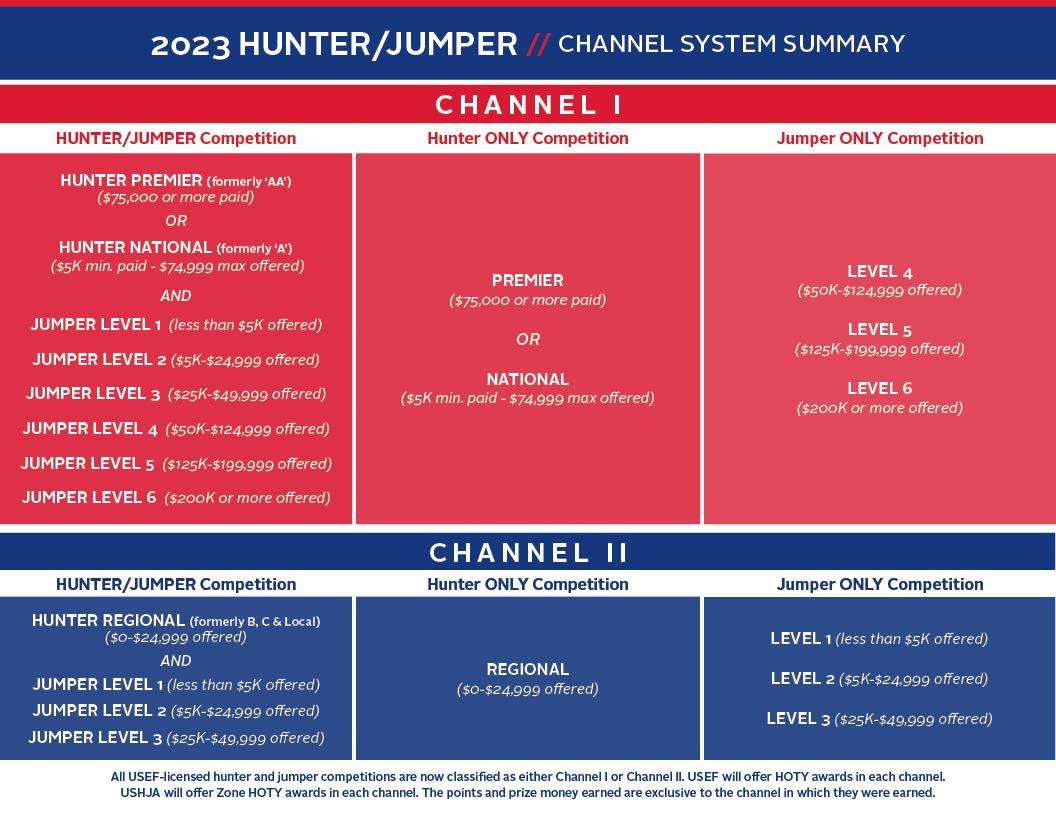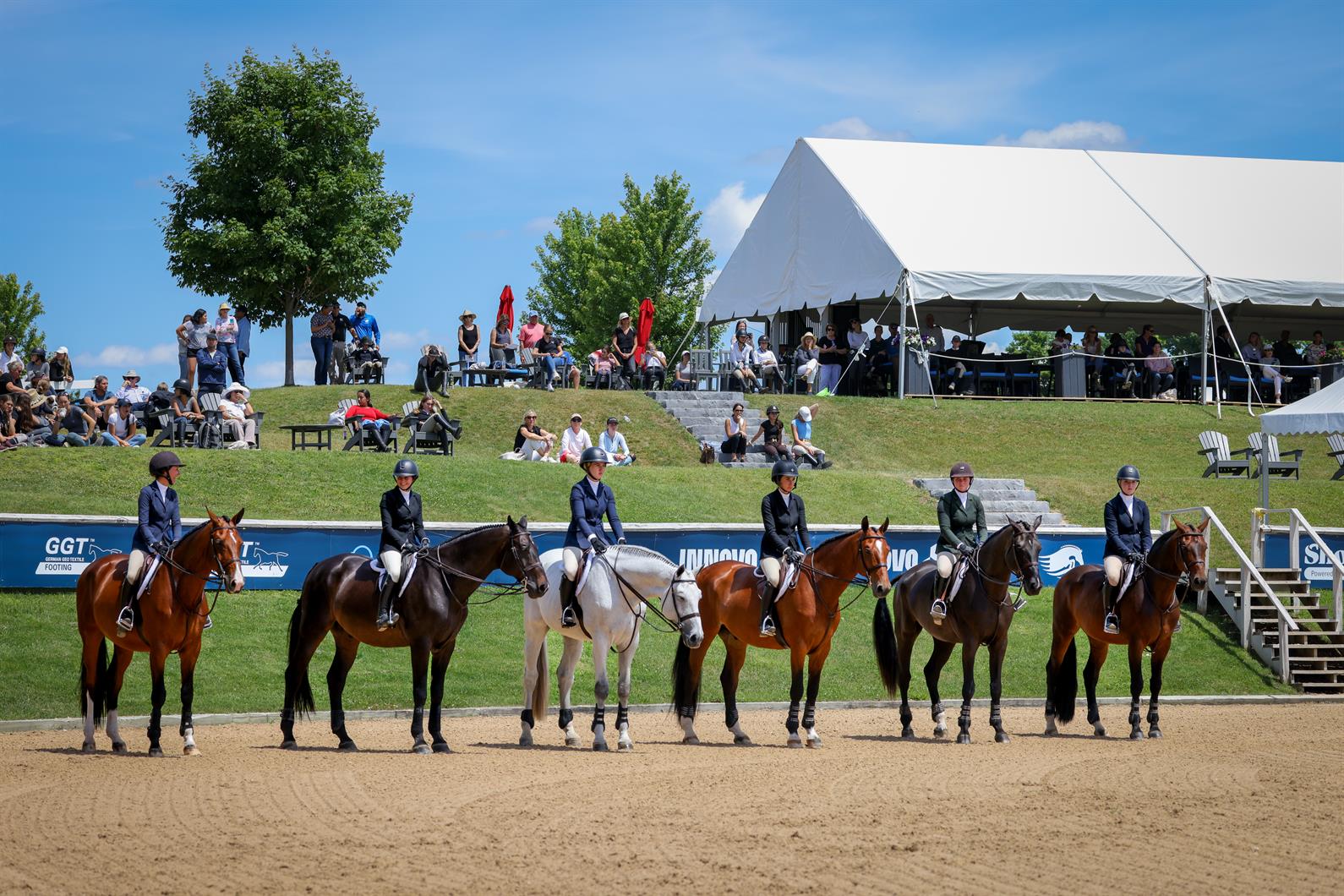
Growing equestrian sport involves providing a variety of opportunities for competitors to enjoy the sport, develop their skills and those of their equine partners, and measure progress. After many months of webinars, feedback from members, and meetings with stakeholder groups, the USEF Competition Task Force proposed amendments to the hunter/jumper competition structure. These amendments were approved by the USEF Board of Directors and are in effect for the 2023 competition year.
Read our hunter/jumper channel system FAQs here.
WHAT CHANGED?
To understand how the updated competition structure may affect you, it’s important to define the components of the new structure.
Hunter Competition Ratings
Previously, there were five hunter ratings: Premier, National, Regional I, Regional II, and Local. Under the new system, there are three: Premier, National, and Regional. The former Regional I, Regional II, and Local ratings have been consolidated under the title of Regional.
Jumper Competition Levels
The jumper levels remain unchanged and are designated as jumper levels 1 through 6.
Hunter Section Ratings
The former “A,” “B,” and “C” designations for hunter sections now align with the competition rating and are known as Premier, National, and Regional. All hunter sections held at a Premier-rated competition will be Premier-rated; there will no longer be “C” rated hunter sections held at Premier- or National-rated competitions.
USEF Horse of the Year (HOTY)
All USEF-licensed hunter and jumper competitions are now classified as either Channel I or Channel II, and USEF will offer National HOTY awards in each channel and USHJA will offer Zone HOTY awards in each channel.
- Channel I includes Premier- and National-rated hunter competitions and standalone jumper level 4-6 competitions. If a Premier- or National-rated competition also offers jumper classes, then Jumper levels 1-6 will be considered Channel I.
- Channel II includes Regional-rated hunter competitions and jumper level 1-3 competitions. Jumper levels 4-6 will not be allowed to run at a Regional-rated competition offering jumper classes.
- It is important to note that points earned in each channel are exclusive to that channel.
Event Qualification
Organizers of competitions that utilize USEF HOTY standings are required to use the channel standings that align with their competition rating. For example, a Premier-rated hunter competition and jumper level 6 competition such as Devon is required to use Channel I standings for qualification. Exception: for 2023 qualifying events only, if a qualifying period for a competition starts prior to December 1, 2022, then the competition will use results from Channel I and II to maintain consistency throughout the process of qualifying for their 2023 events.
Program Qualification
Program owners will have the opportunity to utilize results from one or both channels. For example, USEF will permit points from competitions in both channels to count for qualification to compete in the Dover Saddlery/USEF Hunter Seat Medal Final.
Calendar Management
The mileage boundary between Premier- or National-rated hunter competitions and Regional-rated hunter competitions has been eliminated, and the mileage boundary between Regional-rate hunter competitions has been set at 50 miles. The mileage boundaries for jumper level competitions are unchanged. Of note, there is no mileage boundary for jumper level 1 and 2 competitions. The mileage exemption process remains in place to provide additional competitive opportunities, when warranted, in accordance with the specifics of GR 315 of the USEF Rule Book.
“If you look at the [previous] structure, if you put on a Premier or National horse show in Dallas, that 250-mile radius knocks every other competition from Tulsa to Houston out of the marketplace,” said Britt McCormick, a member of the USEF Competition Task Force that created the Channel System proposal. “That’s a huge chunk of territory with a lot of horses. The idea [under the new system] is that you may have a Premier horse show at one of these megafacilities, but now there’s an opportunity to have a different level of horse show with different prize money, different offerings, and different price points, scattered throughout. That’s huge for sport growth.”
Hunter Prize Money
Prize money for rated hunter competitions has also changed. Previously, the minimum paid prize money requirement for Premier-rated hunter competitions was $24,000. The new requirement raises that minimum to $75,000. The minimum paid prize money for National-rated hunter competitions is $5,000, and the maximum is $74,999. Regional-rated hunter competitions have no minimum requirement, but the maximum is $24,999.
Sissy Wickes, a member of the USEF Competition Task Force who was also instrumental in constructing the new system, emphasizes that show managers should not see Channel II (Regional hunter and jumper levels 1-3) competitions as “less than” their Channel I (Premier or National hunter and jumper levels 4-6) counterparts but as a completely separate pathway that offers flexibility and options that will work better in some markets.
“What are the advantages of Channel II? Opportunity for more competitions closer to home and more flexibility with prize money,” said Wickes. “You can still offer all the same classes [as Channel I] or just some of them; you don’t have to hold the sections that you know aren’t going to fill. It just gives a broader menu of options, and that’s what we’re aiming for. It’s not just one system for everybody.”
WHY THE CHANGE?
McCormick says that the idea of creating the new structure originated with the USHJA Planning

Photo: Leslie Potter/US Equestrian
Committee before being assigned to a United States Hunter Jumper Association task force, and ultimately progressing to the USEF Competition Task Force. The USEF task force worked with multiple groups of trainers, organizers, exhibitors, and the USHJA. It used that feedback to produce the proposed structure, addressing five areas that were identified as important to the hunter/jumper community: safety, fairness, and enjoyment; accessibility in location, cost, and class offerings; quality competitions; meaningful recognition for all levels; and simplifying the sport.
McCormick notes that equestrian is one of the few sports in the U.S. where there are a significant number of competitions operating outside the standardized rules, licensed officials, and safety protocols of a national governing body. He says that the need to bring the hunter/ jumper show community together under a consistent set of standards was a foundation for the idea behind the channel system.
Wickes agrees and says that one aim of the restructure is to offer currently unrecognized competitions access to the benefits of USEF licensing under a more flexible, affordable structure within Channel II.
“The benefits of USEF licensing start with a level playing field. You get horse welfare rules and rider welfare rules. There’s a lot to be said for USEF licensing,” said Wickes. “We recognize that [the channel system] is not a cure for everything. But we have to open up our current methodology.”
Wickes explains that the pool of local, more entry-level shows, which she likens to the base of the pyramid that is the hunter/jumper show circuit, has been shrinking year after year.
“The idea for the channels originated as a calendaring remedy,” she said. “A lot of the smaller shows felt shut out by the calendaring process. For example, in the Northeast, if there is a Premier/National show, it limits other participants; you can’t have a [local] show on the corner. Yet, from our logic, there are plenty of horses to go around, and there should be something for everyone.”
Wickes notes that travel restrictions due to COVID-19 changed the way many equestrians scheduled their show season.
“People started to show closer to home and realized the benefits of that,” she said. “That was an example of what [competing] can be. When you have more options close to home, that means lower shipping costs, lower housing costs, more people can attend, and the community gets involved. It can be a win-win situation.
“With this new process, you can have a Premier/National horse show at one of the big facilities, and you can also utilize other facilities that are within shooting distance for a Regional show,” Wickes continued. “One of the problems in our industry is bringing along young horses. A lot of people buy horses in Europe and leave them there because it’s cheaper. What if we can provide a situation like in Europe where you can have locally based, quality horse shows? We’re going to give you some good prize money. We’re going to give you a chance to win points in your channel. And hopefully—this is up to show managers—we’re going to give you a better price point at Channel II.”
The channel system was created not just to offer recognition for competitors at all levels, but also as an incentive for riders and show managers at all levels to embrace Channel II and experience its benefits.
“For example, we have a megafacility in Houston, and it’s just under the 250 [mileage restriction] to the next facility in the state of Texas,” said McCormick. “That facility is prevented from having [National or Premier] competitions, but they have a different clientele. If we can create the right carrot, the right award structure—if that is the carrot—for that facility to run a different type of horse show, then we get sport growth.”
“For exhibitors, there is the carrot of Channel II HOTY awards. There is the carrot of good prize money and a chance to compete with your own level of rider and perhaps with a lower price point,” said Wickes. “It has to be exhibitor-driven, but it also has to be manager-driven. Give it a try, because I think [Channel II shows] are going to be well attended.”
McCormick sees a huge opportunity for jumpers with Channel II shows, especially for young horses and new riders.
“One of the things I feel like is the strongest reason for a manager to try this is on the jumper side,” said McCormick. “If you offer a rated jumper show with multiple jumper sections for any prize money, because it’s rated there is an expectation of quality, officials, rules, timing equipment, courses, all those things—you’re talking about a European model. We’ve never had that in this country. It’s going to take a manager that’s willing to give it a whirl and lay it on the line a little bit, and I think you’re going to see explosive growth.”


